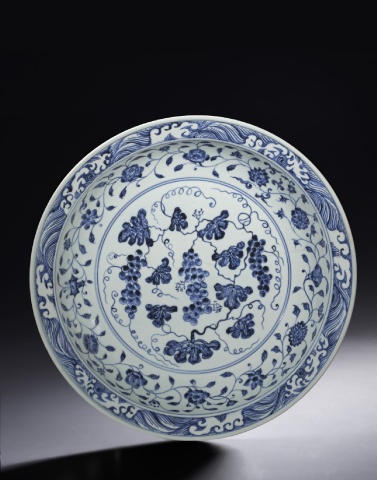Page 181 - Christie's Chinese Works of Art March 24 and 25th, 2022 NYC
P. 181
ANOTHER PROPERTY
ⱷ1045
A RARE BLUE AND WHITE 'GRAPES' DISH suggesting that they may have belonged to a man who served Shah Abbas
YONGLE PERIOD (1403-1425) at the highest level, and indicating the high esteem in which such dishes
were held in Iran. Another similar dish, sold at Sotheby's London, March 24,
The interior is well-painted with a leafy grapevine bearing three bunches of
1964, lot 96, bore an inscription naming Shah Jahan, the Moghul ruler of
grapes as well as coiling tendrils, encircled by a band of composite foliate
India (1627-58). A further example preserved in the Topkapi Saray, Istanbul,
scroll in the rounded cavetto. The everted rim is decorated with a band of
is illustrated by R. Krahl and J. Ayers, Chinese Ceramics in the Topkapi Saray
wind-tossed waves, and the exterior with a further band of composite foliate
Museum Istanbul - II - Yuan and Ming Dynasty Porcelains, London, 1986, p.
scroll, all in inky tones of underglaze blue enhanced by 'heaping and piling.'
514, no. 606. The popularity of such dishes at the Persian, Indian and Turkish
148 in. (38 cm.) diam.
courts explains the influence that dishes of this design exerted on lower-fired
blue and white wares made by the Isnik potters of Turkey. The Isnik potters
$180,000-250,000 produced dishes of similar pattern in the period AD 1530-40. See R. Scott,
The Burrell Collection, London and Glasgow, 1983, p. 79, pl. 11, left-hand side.
PROVENANCE:
Asahi Bijutsu, Tokyo, 1999.
Grapes began to gain popularity as a motif on blue and white porcelain
in the early 15th century, although it had appeared very occasionally on
Large, early 15th-century dishes decorated with grape vines as the main
14th-century porcelains. Grapes are recorded as having been brought to
interior motif can be found in two distinct types. One type has a bracket-
China from Central Asia by Zhang Qian, an envoy of Emperor Wudi, when
lobed rim and lobed cavetto. On this type the flowers in the cavetto are
he returned to China in 128 BC. Both green and black grapes are recorded
painted as individual sprays in each lobe, while the mouth rim is decorated
as being grown in China by the beginning of the 6th century AD, and there
with the so-called 'blackberry lily' scroll. Examples of this type are in a
is even a seedless variety mentioned in texts from the Song dynasty. By
number of collections, including the Percival David Foundation, illustrated
the early 15th century many different varieties of grape were grown. The
by R. Scott, Elegant Form and Harmonious Decoration - Four Dynasties of
grapes were eaten fresh, as well as dried in the form of raisins, but do not
Jingdezhen Porcelain, Percival David Foundation, London, 1992, p. 40, no. 27;
seem to have been used to make wine until the Tang dynasty. Actually, the
the Musée Guimet, Paris, illustrated by D. Lion-Goldschmidt, Ming Porcelain,
Yongle dish with this blue and white porcelain design provides an interesting
New York, 1978, pl. 25; the British Museum, illustrated by J. Harrison-Hall,
illustration of the way influences travelled back and forth across Asia. Both
Ming Ceramics in the British Museum, London, 2001, p. 117, no. 3:36; and the
the grape plant and its use as a decorative motif entered China from the
Indianapolis Museum of Art, illustrated by Y. Mino & J. Robinson, Beauty and
West during the Han dynasty, but in the 15th century Chinese dishes with
Tranquility: The Eli Lilly Collection of Chinese Art, Indianapolis Museum of Art,
this design travelled West entering palace collections in Iran, India and
1983, pp. 236-7, no. 92, among others. A dish of this type, bearing a Xuande
Turkey. Turkish potters then copied the Chinese blue and white dishes
mark, excavated from the site of the imperial kiln, is illustrated in Jingdezhen
depicting grapes in their Isnik blue and white wares.
chutu Yuan Ming guanyao ciqi, Beijing, 1999, p. 198, no. 159.
The second, rarer, group, to which the current dish belongs, is usually
associated with the Yongle reign. These dishes have a smooth cavetto 明永樂 青花纏枝葡萄紋盤
and circular mouth rim. Their cavettos are decorated with a mixed flower 來源:
scroll, and the flattened rims with a classic early 15th-century turbulent 朝日美術, 東京, 1999年
wave band. Examples of this type are to be found in the Percival David
Foundation, Illustrated Catalogue of Underglaze Blue and Copper Red
Decorated Porcelains, London, rev. ed., 2004, pp. 47-8, no. 685, and the
Shanghai Museum, Qinghua ciqi zhan - Shanghai bowuguan suozang, 1988,
p. 45, no. 24. There are five dishes of this type preserved in the collection
from the Ardebil Shrine, now in the Iran Bastan Museum, Tehran. See J. A.
Pope, Chinese Porcelains from the Ardebil Shrine, London, 1981, p. 38, nos.
29.50-54. Each of these has the Qarachaghay mark drilled into the base,
17
178 8 179

